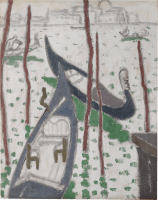Jessica Dismorr was an experimental force within twentieth-century modernism in Britain. A frontrunner of British abstraction, a signatory of the radical Vorticist movement, and a politically engaged professional artist, Dismorr’s artistic imprint on British art is marked. Painted during her formative years as a truly modern artist, the present work demonstrates her move away from traditional realism in favour of avant-garde European trends.
In this atmospheric view of Venice, Dismorr foregrounds two gondolas floating between mooring poles. The protrusive poles intersect the composition and draw the eye to the iconic horizontal silhouette of Venice in the background. At this date, landscape painting was undergoing a dramatic shift among British artists. With the increasing influence of modernist European art - predominantly Parisian movements such as Cubism and Fauvism – British artists steadily began to experiment with radically new ideas. As seen here, Dismorr was at the forefront of this shift, moving away from traditional notions of landscape painting. Her early works...
Jessica Dismorr was an experimental force within twentieth-century modernism in Britain. A frontrunner of British abstraction, a signatory of the radical Vorticist movement, and a politically engaged professional artist, Dismorr’s artistic imprint on British art is marked. Painted during her formative years as a truly modern artist, the present work demonstrates her move away from traditional realism in favour of avant-garde European trends.
In this atmospheric view of Venice, Dismorr foregrounds two gondolas floating between mooring poles. The protrusive poles intersect the composition and draw the eye to the iconic horizontal silhouette of Venice in the background. At this date, landscape painting was undergoing a dramatic shift among British artists. With the increasing influence of modernist European art - predominantly Parisian movements such as Cubism and Fauvism – British artists steadily began to experiment with radically new ideas. As seen here, Dismorr was at the forefront of this shift, moving away from traditional notions of landscape painting. Her early works are characterised by their simplified forms, bold colour-blocking, and heavy linear contouring – a style she developed under the tutelage of Scottish colourist John Duncan Fergusson, whilst studying at the Académie de la Palette in Paris during c.1910-12.
Venice with Gondolas and Church also reflects Dismorr’s integration with the Rhythm group, a group of artists who pioneered Fauvism in Britain. In 1912, she exhibited five works – including a Venetian landscape – with Rhythm in the group’s only known exhibition at the Stafford Gallery, London. She has since been lauded by art historians, such as Anna Gruetzner Robins, as the group’s greatest colourist and most expressive painter.[1] Dismorr is now perhaps best known for her work with the Vorticist group during the 1920s, and her abstract work of the later 1930s. Today, she is represented in collections such as Tate and the National Portrait Gallery, London.
[1] A. G. Robins. (1997), Modern Art in Britian. London: Barbican Centre, p.113.













